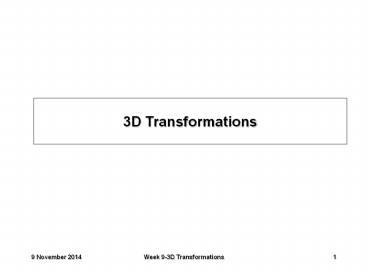3D Transformations - PowerPoint PPT Presentation
1 / 14
Title:
3D Transformations
Description:
Rotation about a major axis. z. x. y. z. x. y. z. x. y. 11/26/09. Week 9-3D Transformations. 7 ... Rotate the axis of rotation so it lies on some major axis. ... – PowerPoint PPT presentation
Number of Views:27
Avg rating:3.0/5.0
Title: 3D Transformations
1
3D Transformations
2
3D homogeneous coordinates
- In 2D, we added a dimension so translations could
be computed by matrix multiplication, just like
all the other transformations. - In 3D, well do the same trick, projecting up
into a 4D space to do transformations, then
projecting back down after.
3
Translation
(x,y,z)
T(tx,ty,tz)
(x,y,z)
4
Scaling
5
Rotation
- How should we specify rotations?
- In 2D, it was always counterclockwise in the
xy-plane. - In 3D, we have more choices.
- xz-plane, yz-plane, an arbitrary plane.
- We could specify these in terms of the vector
perpendicular to the plane of rotation. - z axis, y-axis, x-axis, arbitrary axis
6
Rotation about a major axis
y
y
z
x
z
y
x
z
x
7
Rotation about an arbitrary axis
- How do we specify this?
- R(rx, ry, rz, ?)
- So we need a vector and an angle
- The axis of rotation is from the origin and
through the point r - The rotation is counterclockwise about the axis
y
z
x
8
What are the steps?
- Rotate the axis of rotation so it lies on some
major axis. - Apply specified rotation about major axis.
- Apply inverse rotation to return axis or rotation
to original orientation.
y
y
x
z
x
z
9
Math!
- We need to figure out the rotations to align the
axes. - First, compute a unit vector pointing in the same
direction as the axis of rotation. - Now we can compute the rotation directly from the
unit vector.
10
More math!
- First, rotate u into the xz-plane rotation
around the x-axis. - We can temporarily ignore the x component of u to
do this
y
u lt0,b,cgt
ulta,b,cgt
?
uzlt0,0,1gt
z
x
ulta,0,dgt
11
Picture this
Second, rotate u onto the z-axis rotation
around the y-axis.
?
uzlt0,0,1gt
ulta,0,dgt
12
Putting it together
- Dont forget the rotation about the z-axis!
- P R(ux,?) R(uy,?) R(uz,?) R(uy,?)
R(ux,?) P
13
Other rotations
- What if the axis of rotation does not pass
through the origin? - Similar process as in 2D, translate to the
origin, rotate as normal, translate back. - We just need to know a point on the axis that we
can translate to the origin. - Only way to specify such a rotation is to give
two points on the line or one point and a
direction, so the requirement is easily satisfied.
14
Another way to get the rotation matrix
- We can compute it as a coordinate system
transformation
y
uz
uy
ux
z
x































